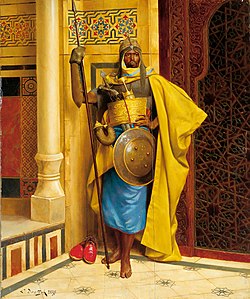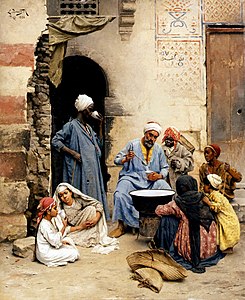art.wikisort.org - Artist
Ludwig Deutsch (13 May 1855 – 9 April 1935) was a French painter of Austrian origin, who settled in Paris and became a noted Orientalist artist. Having studied at the Vienna Academy of Fine Arts from 1872 to 1875, he moved to Paris in 1878, where he became associated with other Orientalist painters. Most of his works were painted in his studio in Paris, but he had visited Egypt on several journeys from 1885 to 1898. In 1919, he became a French citizen and started to write his name as Louis Deutsch.
Ludwig Deutsch | |
|---|---|
 The Scribe painting by Ludwig Deutsch, 1911 | |
| Born | 13 May 1855 Vienna, Austrian Empire |
| Died | 9 April 1935 (aged 79) Paris, France |
| Nationality | Austrian |
| Education | Vienna Academy of Fine Arts (1872–1875) |
| Known for | Painting |
| Movement | Orientalism |
Life and career
Details of Ludwig Deutsch's life are obscure. He was born in Vienna in 1855 into a well-established Jewish family. His father Ignaz Deutsch was a financier at the Austrian court.[1]
He received his early art training at the Akademie der Bildenden Künste (Academy of Fine Arts Vienna) under the tutelage of Anselm Feuerbach (1875–1877). In 1877, when Feuerbach retired as a teacher, Deutsch and some others students attempted to enter the class of Leopold Carl Müller, who had moved to Paris in 1876, but initially were refused entry. In 1878 Deutsch was finally accepted. At around this time, he may also have studied with Jean-Paul Laurens.[2] In Paris, Deutsch made the acquaintance of artists Arthur von Ferraris, Jean Discart and Rudolf Ernst, who became his lifelong friend.[3][4] Through these friendships, Deutsch developed an interest in Orientalist art.
Around 1880, he broke his contacts with Vienna and settled permanently in Paris. He established a studio at the Rue Le Pelletier in Paris and began to exhibit paintings with much success.[5]
Though his earliest Orientalist subjects appeared in 1881, Deutsch's first documented journeys to the Middle East were made in 1885, 1890, and 1898, when he visited Egypt.[6] Throughout the 1890s, he visited Egypt at least three times. Like many of his contemporaries, he found inspiration in the North African light, colours, scenery and customs. He collected a vast quantity of Oriental objects, including tiles, furniture, arms, pipes, fabrics, and costumes, which he would subsequently use in his paintings.[7]
Work
His early work focused primarily on historical subjects, but after visiting Egypt, he concentrated on Orientalist scenes. He was particularly interested in capturing the rich, opulent scenes of Cairo and its environs. The detail in his paintings is excellent. He was prolific, producing many paintings with the same theme – prayers, guards, musicians, street vendors etc.[8] In order to produce paintings in large volume, he created a very economical approach, using the same settings with different subjects and activities to create an impression of variety.[9]
Many of Ludwig Deutsch's paintings are now in the Shafik Gabr Collection.[10] Amongst his best known works are: The Scribe, painted 6 years after Paul Joanowits did Bashi-Bazouks Before a Gateway but in the same location, and Musical Interlude. Among Austrian Orientalist painters, his works are considered to be some of the most sought after by collectors.[11]
Like many of his contemporaries, including Paul Joanovitch, Rudolf Ernst and Jean-Léon Gérôme, Deutsch made extensive use of photography to ensure archaeological accuracy in his painted renderings of local architectural features (e.g. tiles, ablaq stone work, and the traditional mashrabiyyah woodwork) in what has been described as "documentary realism". Nissan N. Perez, Curator of Photography at the Israel Museum, wrote for example, that "the details in masonry and the angle of view in Deutsch's paintings El Azhar - The Arab University in Cairo (1890) and The Scribe (1904)" are doubtlessly inspired by photographs of Cairo-based photographer Gabriel Lekegian of the same places.[12] This allowed him to use the Orient as inspiration, but to produce most of his paintings in his Paris studio.[13]
Selected paintings
- The Nubian Palace Guard, date unknown
- The Inspection, 1883
- The Sahleb Vendorm, 1886
- The chess game between Tha'ālibī and Bakhazari, 1896
 In the Madrasa, c.1900
In the Madrasa, c.1900- The Smoker, 1903
- The Furniture Maker, 1900
Select list of paintings
- The Domino Players, 1882
- An Orientalist Amateur, 1883 (Painting exhibited at the Salon of French Artists, and now presumed lost)
- The Musician, 1883
- The Sentinel, 1885
- News from Sudan, 1885
- The Answer, 1886
- The Sherbert Vendor, 1886
- The Hour of Prayer, 1887
- The Snake Charmers, 1888
- Court of El Azhar University, Cairo, 1890
- The Healer, 1891
- The Orange Seller, 1892
- The Palace Guard, 1892
- The Emir's Guard, 1893
- The Scribe, 1894
- The Scholar, 1895
- The Chess Game 1896
- The Philosopher, 1897
- The Offering, 1897
- Prayer at the Tomb, 1898
- Leaving the Mosque, 1900
- The Learned, 1900
- Interior of Mosque, 1902
- The Harem Watchman 1903
- The Koran School, 1905
- Morning Prayer, 1906
- The Narghil Smoker, 1907
- Le Maitre, 1907
- The Procession of the Mahmal through the Streets of Cairo, 1909
- At Prayer, 1911
- The Scribe, 1911
- The Treasure Chest, 1920
- At Prayer, 1923
- The Fortune Teller, 1927
- Musical Interlude, 1932
See also
References
- Guenther Wimmer, Martina Haja: Les Orientalistes des Ecoles allemande et autrichienne. Courbevoie 2000. ISBN 978-2-86770-140-5
- Thornton, L., The Orientalists: Painter-travellers, 1828–1908, Volume 1, ACR Édition, 1983, p. 210
- Orientalism: Delacroix to Klee Roger Benjamin, Mounira Khemir, Ursula Prunster – 1997 "Rudolph Ernst, like his friend Ludwig Deutsch, was a Viennese-born Orientalist who settled in Paris during the 1870s."
- Hali, The international magazine of antique carpet and textile art: Volume 8 1986 "Ludwig Deutsch is perhaps the Austrian Orientalist most sought after by collectors. One of his works on show, 'The Scholar', is a fine example of the artist at his very best. Dated 1901 and painted in Paris, like the vast majority of his works, it has ..."
- Roger Benjamin, Mounira Khemir, Ursula Prunster (1997) Orientalism: Delacroix to Klee. "Rudolph Ernst, like his friend Ludwig Deutsch, was a Viennese-born Orientalist who settled in Paris during the 1870s."
- Weeks, E.M., "Ludwig Deutsch," [Catalog Note], Bonhams, Online: https://www.bonhams.com/auctions/24213/lot/48/
- AlSayyad, N., Bierman, I.A. and Rabbat, N., Making Cairo Medieval, Lexington Books, 2005, p. 117
- Netton, I.T., Orientalism Revisited: Art, Land and Voyage, Routledge, 2012, p. 123
- AlSayyad, N., Bierman, I.A. and Rabbat, N., Making Cairo Medieval, Lexington Books, 2005, p. 117
- Gabr, S., Shafik Gabr: Masterpieces of Orientalist Art: The Shafik Gabr Collection, ACR edition, 2012
- Hali, The international magazine of antique carpet and textile art: Volume 8 1986 "Ludwig Deutsch is perhaps the Austrian Orientalist most sought after by collectors. One of his works on show, The Scholar. is a fine example of the artist at his very best. Dated 1901 and painted in Paris, like the vast majority of his works, it has ..."
- Perez, Nissan N. (1988) Focus East: Early Photography in the Near East 1839-1885. New York: Harry N. Abrams, Inc., p.190
- Behdad, A., Camera Orientalis: Reflections on Photography of the Middle East, University of Chicago Press, 2016, p. 25; Behdad, A, and Gartlanm (eds)., Photography's Orientalism: New Essays on Colonial Representation, Getty Publications, p. 16
На других языках
[de] Ludwig Deutsch
Ludwig Deutsch (auch Louis Deutsch; * 13. Mai 1855 in Wien; † 9. April 1935 in Paris) war ein österreichischer Maler des Orientalismus. Er war in Paris tätig und erhielt 1919 die französische Staatsbürgerschaft.- [en] Ludwig Deutsch
[fr] Ludwig Deutsch
Ludwig Deutsch, né à Vienne le 13 mai 1855[1],[2] et mort à Paris le 9 avril 1935, est un peintre orientaliste autrichien naturalisé français.[ru] Дойч, Людвиг
Людвиг Дойч (нем. Ludwig Deutsch, 1855—1935) — художник-ориенталист австрийского происхождения, постоянно проживавший во Франции. В 1919 году принял французское гражданство. Родился в состоятельной еврейской семье. Его отец был финансистом в австрийском суде. Образование начинал в Венской академии изящных искусств под руководством Ансельма фон Фейербаха. С 1875 года жил в Париже, где работал под руководством Жан-Поля Лорана. В Париже Дойч познакомился с художниками Артуром фон Феррари, Жаном Дискартом и Рудольфом Эрнстом, которые стали его друзьями на всю жизнь. Начинал как исторический живописец, в 1885 году впервые посетил Египет и с тех пор писал современный ему Восток. Совершил как минимум пять путешествий в страну пирамид. Сюжетно большинство его картин — изображение жизни и быта Каира конца XIX века. В 1900 году удостоен Золотой медали Всемирной выставки в Париже.Другой контент может иметь иную лицензию. Перед использованием материалов сайта WikiSort.org внимательно изучите правила лицензирования конкретных элементов наполнения сайта.
WikiSort.org - проект по пересортировке и дополнению контента Википедии






